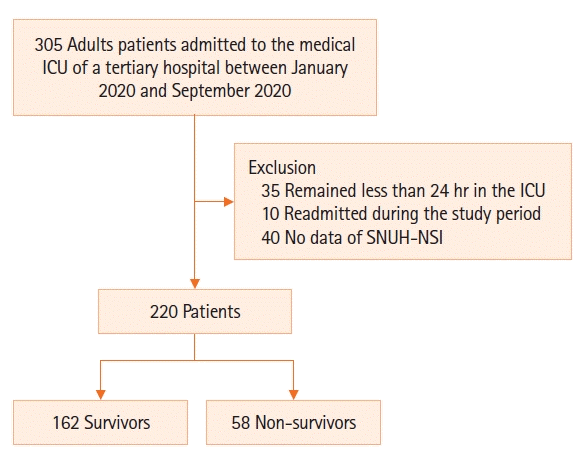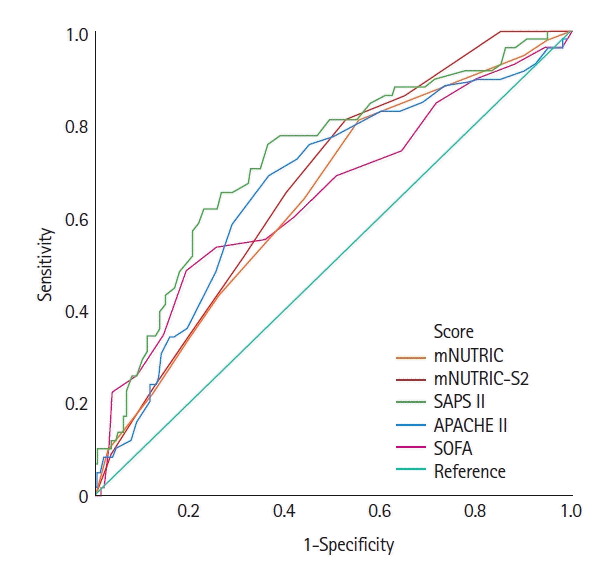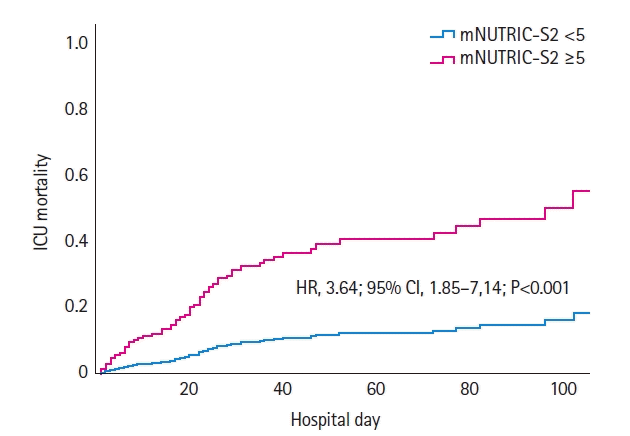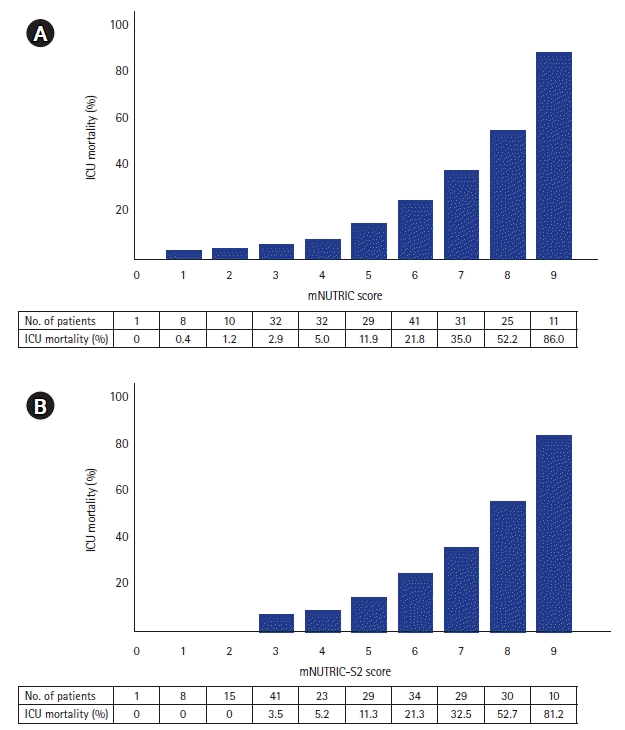1. Villet S, Chiolero RL, Bollmann MD, Revelly JP, Cayeux R N MC, Delarue J, et al. Negative impact of hypocaloric feeding and energy balance on clinical outcome in ICU patients. Clin Nutr. 2005; 24:502–9.

2. Doig GS, Simpson F, Finfer S, Delaney A, Davies AR, Mitchell I, et al. Effect of evidence-based feeding guidelines on mortality of critically ill adults: a cluster randomized controlled trial. JAMA. 2008; 300:2731–41.

3. Schneider SM, Veyres P, Pivot X, Soummer AM, Jambou P, Filippi J, et al. Malnutrition is an independent factor associated with nosocomial infections. Br J Nutr. 2004; 92:105–11.

4. Kyle UG, Pirlich M, Schuetz T, Lochs H, Pichard C. Is nutritional depletion by Nutritional Risk Index associated with increased length of hospital stay?: a population-based study. JPEN J Parenter Enteral Nutr. 2004; 28:99–104.

5. Giner M, Laviano A, Meguid MM, Gleason JR. In 1995 a correlation between malnutrition and poor outcome in critically ill patients still exists. Nutrition. 1996; 12:23–9.

6. Mukhopadhyay A, Henry J, Ong V, Leong CS, Teh AL, van Dam RM, et al. Association of modified NUTRIC score with 28-day mortality in critically ill patients. Clin Nutr. 2017; 36:1143–8.

7. McClave SA, Taylor BE, Martindale RG, Warren MM, Johnson DR, Braunschweig C, et al. Guidelines for the provision and assessment of nutrition support therapy in the adult critically ill patient: Society of Critical Care Medicine (SCCM) and American Society for Parenteral and Enteral Nutrition (A.S.P.E.N.). JPEN J Parenter Enteral Nutr. 2016; 40:159–211.

8. Heyland DK, Dhaliwal R, Jiang X, Day AG. Identifying critically ill patients who benefit the most from nutrition therapy: the development and initial validation of a novel risk assessment tool. Crit Care. 2011; 15:R268.

9. Rahman A, Hasan RM, Agarwala R, Martin C, Day AG, Heyland DK. Identifying critically-ill patients who will benefit most from nutritional therapy: further validation of the “modified NUTRIC” nutritional risk assessment tool. Clin Nutr. 2016; 35:158–62.

10. Knaus WA, Draper EA, Wagner DP, Zimmerman JE. APACHE II: a severity of disease classification system. Crit Care Med. 1985; 13:818–29.
11. Moreno RP, Nassar AP Jr. Is APACHE II a useful tool for clinical research? Rev Bras Ter Intensiva. 2017; 29:264–7.

12. Jeong S. Scoring systems for the patients of intensive care unit. Acute Crit Care. 2018; 33:102–4.

13. Harrison DA, Lone NI, Haddow C, MacGillivray M, Khan A, Cook B, et al. External validation of the Intensive Care National Audit & Research Centre (ICNARC) risk prediction model in critical care units in Scotland. BMC Anesthesiol. 2014; 14:116.

14. Brinkman S, Bakhshi-Raiez F, Abu-Hanna A, de Jonge E, Bosman RJ, Peelen L, et al. External validation of Acute Physiology and Chronic Health Evaluation IV in Dutch intensive care units and comparison with Acute Physiology and Chronic Health Evaluation II and Simplified Acute Physiology Score II. J Crit Care. 2011; 26:105.

15. Sathe PM, Bapat SN. Assessment of performance and utility of mortality prediction models in a single Indian mixed tertiary intensive care unit. Int J Crit Illn Inj Sci. 2014; 4:29–34.

16. Schellongowski P, Benesch M, Lang T, Traunmüller F, Zauner C, Laczika K, et al. Comparison of three severity scores for critically ill cancer patients. Intensive Care Med. 2004; 30:430–6.

17. Moreno R, Morais P. Outcome prediction in intensive care: results of a prospective, multicentre, Portuguese study. Intensive Care Med. 1997; 23:177–86.

18. Castella X, Artigas A, Bion J, Kari A. A comparison of severity of illness scoring systems for intensive care unit patients: results of a multicenter, multinational study. Crit Care Med. 1995; 23:1327–35.
19. Seol E, Ju DL, Lee HJ. Nutritional screening tool for in-hospital patients. J Clin Nutr. 2016; 8:2–10.

20. Poole D, Rossi C, Latronico N, Rossi G, Finazzi S, Bertolini G, et al. Comparison between SAPS II and SAPS 3 in predicting hospital mortality in a cohort of 103 Italian ICUs: is new always better? Intensive Care Med. 2012; 38:1280–8.

21. Jeong DH, Hong SB, Lim CM, Koh Y, Seo J, Kim Y, et al. Comparison of accuracy of NUTRIC and modified NUTRIC scores in predicting 28-day mortality in patients with sepsis: a single center retrospective study. Nutrients. 2018; 10:911.

22. Jung YT, Park JY, Jeon J, Kim MJ, Lee SH, Lee JG. Association of inadequate caloric supplementation with 30-day mortality in critically ill postoperative patients with high modified NUTRIC score. Nutrients. 2018; 10:1589.

23. Im KM, Kim EY. Identification of ICU patients with high nutritional risk after abdominal surgery using modified NUTRIC score and the association of energy adequacy with 90-day mortality. Nutrients. 2022; 14:946.

24. Jeong DH, Hong SB, Lim CM, Koh Y, Seo J, Kim Y, et al. Relationship between nutrition intake and 28-day mortality using modified NUTRIC score in patients with sepsis. Nutrients. 2019; 11:1906.

25. Kim Y, Kim WG, Lee HJ, Park MS, Lee YH, Kong SH, et al. Comparison of the impact of malnutrition by nutritional assessment and screening tools on operative morbidity after gastric cancer surgery. J Korean Soc Parenter Enter Nutr. 2011; 4:7–15.

26. Kim Y, Kim WG, Lee HJ, Park MS, Lee YH, Cho JJ, et al. Impact of Malnutrition risk determined by Nutrition Screening Index on operative morbidity after gastric cancer surgery. J Korean Surg Soc. 2011; 80:1–9.

27. Lee ZY, Hasan MS, Day AG, Ng CC, Ong SP, Yap CS, et al. Initial development and validation of a novel nutrition risk, sarcopenia, and frailty assessment tool in mechanically ventilated critically ill patients: the NUTRIC-SF score. JPEN J Parenter Enteral Nutr. 2022; 46:499–507.

28. Toledo DO, Junior JM, Toloi JM, de Assis T, Serra LM, do Carmo PG, et al. NUTRIC-S proposal: using SAPS 3 for mortality prediction in nutritional risk ICU patients. Clin Nutr Exp. 2020; 31:19–27.

29. Oliveira ML, Heyland DK, Silva FM, Rabito EI, Rosa M, Tarnowski MD, et al. Complementarity of modified NUTRIC score with or without C-reactive protein and subjective global assessment in predicting mortality in critically ill patients. Rev Bras Ter Intensiva. 2019; 31:490–6.
30. Ugarte H, Silva E, Mercan D, De Mendonça A, Vincent JL. Procalcitonin used as a marker of infection in the intensive care unit. Crit Care Med. 1999; 27:498–504.

31. Cattani A, Eckert IC, Brito JE, Tartari RF, Silva FM. Nutritional risk in critically ill patients: how it is assessed, its prevalence and prognostic value: a systematic review. Nutr Rev. 2020; 78:1052–68.

32. Kucuk B, Baltaci Ozen S, Kocabeyoglu GM, Mutlu NM, Cakir E, Ozkocak Turan I. NUTRIC score is not superior to mNUTRIC score in prediction of mortality of COVID-19 patients. Int J Clin Pract. 2022; 2022:1864776.

33. Zhang P, Bian Y, Tang Z, Wang F. Use of nutrition risk in critically ill (NUTRIC) scoring system for nutrition risk assessment and prognosis prediction in critically ill neurological patients: a prospective observational study. JPEN J Parenter Enteral Nutr. 2021; 45:1032–41.









 PDF
PDF Citation
Citation Print
Print



 XML Download
XML Download